Physical-Model-Checking to Detect Switching-Related Attacks in Power Systems
Abstract
:1. Introduction
1.1. Motivation
1.2. Related Work
- (1).
- False Data Injection Attacks (FDIA)s that target sensor or meter measurements. In these types of attacks, attackers attempt to feed back to the controller fake sensor measurements to alter its operation. For instance, a malware in [8] showed that injecting high current values into a substation’s network could cause controllers to issue unwanted trip signals, jeopardizing the reliability of the power system. There are extensive efforts on detecting and mitigating FDIAs. For instance, the authors in [9] presented an algorithm based on the linear Weighted Least Square Error (WLS) to detect bad or corrupted sensor measurements in digital substations. However, there are practical limitations on the WLS method, such as the latency. In [10], a false data injection attack detection mechanism, which based on identifying a set of candidate invariant microgrid parameters, was introduced. This method was designed specifically for DC microgrids. In [2], the authors focused on detecting fake sensor measurements in power systems and enhancing the reliability of power grid by forecasting the values of lost measurements, due to network congestion, based on historical trends. Similarly, there are plenty of other works that are focused on FDIAs, such as [11,12,13].
- (2).
- Control-related attacks that target control commands going to actuators and field devices. There are few recent efforts that have been placed to detect control-related attacks in the energy sector that incorporates physical rules along with cyber rules. In [1], a semantic analysis framework, which integrates network IDS with power flow analysis was proposed to detect malicious control commands. To achieve acceptable detection latency, this technique requires adapting the power flow analysis algorithm, leading to a tradeoff between accuracy and latency, as the system expands. In [14], an anomaly detection algorithm, which is specific for detecting attacks on automatic generation control, is proposed. In the former, the control signal is executed on the physical system only if it is regarded as legitimate by the anomaly detection engine, otherwise, a signal from a model-based automatic generation control is utilized. This work relies on the assumption that the feed-back frequency and tie-line measurements are trusted and do not discuss their security requirements. In [15], faults are distinguished from cyber-attacks by following a mathematical formulation that incorporates PMU data, event status, and monitoring logs. Similarly, the work in [16] utilizes lookup tables for current measurements and circuit breakers statuses to compare current and previous states for attack detection. Both [15,16] require that data collection for the detection algorithms to be performed by a trusted entity, which is not always the case [17].
1.3. Paper Contribution
- While the work in the literature assesses network packets against mathematical models of the power system, to the best of the authors’ knowledge, this is the first effort to discuss the use of machine intelligence to develop a content-aware intrusion detection and prevention system that decodes and understands the physical meaning of the content of network packets.
- The use of AI reduces the online computational burden as compared to complex mathematical models and therefore, accelerates the attack detection and decision-making processes (in the μs range).
- Taking appropriate preventive action upon detecting malicious control commands and not only detecting intrusions.
- Finally, implementing the developed security multi-agent system on a hardware laboratory scale power system with an IEC 61850 communication architecture, taking into consideration the practical aspects that arise from the hardware implementation of the power system, agents as embedded microcontrollers, and communication network. The obtained results from the experimental setup proved the feasibility of the proposed security algorithm in real-time physical power systems.
1.4. Paper Organization
2. The Artificially Intelligent Physical-Model Checking Approach
2.1. Current Standards and Associated Cyber Threats
Attack Model
- Automatic Switching Commands: These are commands exchanged between IEDs/Agents to clear short-circuit faults, and they are usually exchanged over a Local Area Network (LAN). Typically, these messages are either DNP3.0 switching commands or GOOSE commands.
- Manual Switching Commands: These are commands sent by the system operator in the control center over a Wide Area Network (WAN). These messages could be either DNP3.0 or Routable GOOSE (R-GOOSE) messages, as defined in IEC TR 61850-90-5 for Routable GOOSE over WAN.
2.2. The Proposed Security Algorithm
2.2.1. The AI Module
2.2.2. The Expert System Module
- Very Low (VL), repressing severe under voltage and Very High (VH), representing severe over voltage.
- High (H), representing normal condition and Low (L), representing mild undervoltage. For the latter case, a corrective action is necessary, such as reactive voltage support.
- For the cases in which the control commands will lead the power system to have extreme over-voltage (represented by VH) or extreme under-voltage (represented by VL) on any of its busses, or extreme overloading of any of its transmission lines (represented by STE), the control command will be considered malicious by the fuzzy inference system. This is because, under no reasonable circumstance, will the system operator perform circuit breakers switching actions that will put the power system in an insecure state, which might be the cause of cascaded blackouts.
- For the cases in which the control commands will lead the power system to have low voltages (represented by L) on one of the busses that has a main generator and/or a critical load connected to it, the fuzzy inference system will consider command will also consider the command as malicious. This is because such critical buses must maintain good voltage conditions at all times.
- For the cases in which the voltage ends up to be low (represented by L) on the buses, which are not accounted for in the second rule (Rule 2), or when the transmission line loading condition is expected to be LTE, the control commands will be passed. However, the system operator will receive an alert signal over the out-of-band channel, in order to see if further actions are necessary.
- For the remaining cases, in which the incoming control commands do not place the power system in an insecure state, the fuzzy inference system will pass the control commands without any issue.
3. Simulation Results
- Generating the Training and Test Target Data Sets: First, in this work, we assume N-1 contingency cases (i.e., disconnecting the transmission lines, one at a time) and the disconnection of the generators and the loads. For the simulated 14-bus system, this gives us 36 cases plus the normal case, where all the circuit breakers are closed. For each case, the power flow problem was solved and the real power (P), reactive power (Q), and bus voltage (V) at the different busses, and transmission line loading (TLL) results were recorded as follows:where, [PiBus1 … PiBusN], [QiBus1 … QiBusN], and [ViBus1 … ViBusN] are the real power, reactive power, and voltage of the system busses, respectively, and . [TLLi1 … TLLiK] are the transmission lines loading, and .
- Generating the Training and Test Input Data Sets: Second, in this case study, the switching commands corresponding to each contingency were mapped to a 6-bit binary code, as shown in the matrix below. For instance, the code 000010 will be utilized to represent a control signal to actuate circuit breakers connecting bus 1 to bus 2.
- Training the Neural Network: The neural network of the agent was trained according to the Back Propagation algorithm to accurately predict the system response in terms of the real power, reactive power, and voltage of the buses and the transmission line loading.
- Cases 21–25 and 29–31 correspond to the disconnection of either a generation unit or a critical load from the system. Since the override signal was set to zero throughout the experiment, these commands were regarded as malicious and, therefore, were not passed to the circuit breakers.
- Cases 9, 11, 12, 15, 18–20, 27, 28, and 33–36 resulted in alert situation, where the commands were passed but an alert was issued to the system operator. It was noticed that there were no severe bus voltage deviations in these cases from the allowable limits. In fact, in all the cases, the minimum bus voltage was 1.02 p.u. Also, the maximum recorded transmission line loading was 129%, which falls into the LTE state of Table 2.
- Cases 1–4, 7, 8, 10, and 14 violated the physical operation constraints of the power system, and thus, were regarded as malicious by the agents.
- The rest of the cases were regarded as normal. It is worth noting that in these cases, commands to disconnect non-critical loads, such as cases 27 and 28, were passed. Although these commands might be malicious or erroneous, they were passed by the multi-agent system since they did not put the power system in a contingency state and the power system maintained its stability. Therefore, the multi-agent system was successful in satisfying its purpose by ensuring that only signals that do not violate the stable operational limits of the power system will be passed.
4. Hardware Setup and Experimental Results
4.1. Description of the Hardware Setup
- -
- Two generation units Generator 1 and Generator 2 with 13.8 KVA 230 V and 5 KW and 10.3 KVA 230 V and 3 KW, respectively.
- -
- Seven distribution lines with a typical π-models.
- -
- Three loads each having 10 levels of parallel resistive loads ranging from 300-W to 3-kW. In this experiment, L1, L2, and L3 are set at 600 W each. L3 is considered to be a critical load, and therefore, has a redundant path to the generation units.
- -
- Each of the five buses has three sets of three-phase inputs and outputs with 530 V/25 A solid-state relays whose switching can be controlled by digital inputs. Each phase has its own potential and current transformer for measurement data collection.
4.2. Information Exchange and Agent Development
4.3. Results and Discussion
- R1: Normal condition. All circuit breakers are closed.
- R2: Disconnection of slack generator (G1).
- R3: Disconnection of generator 2 (G2).
- R4: Disconnection of load 1 (L1).
- R5: Disconnection of critical load 3 (CL3).
- R6: Disconnection of load 2 (L2).
- R7: Disconnecting the circuit breakers between bus 4 and bus 5, which represents the main path to CL3.
- R8: Disconnecting the circuit breakers between bus 1 and bus 5, representing the redundant path to CL3.
- R9: Disconnecting the path between G1 and G2.
Latency Due to the Proposed Security Algorithm
5. Conclusions and Future Work
Author Contributions
Acknowledgments
Conflicts of Interest
Appendix A. Parameters of the Simulation and Hardware Setups
| Generator Number | Real Power (MW) | Reactive Power (MVAR) | ||
| Min | Max | Min | Max | |
| 1 | 10 | 160 | 0 | 10 |
| 2 | 20 | 80 | −42 | 50 |
| 3 | 20 | 50 | 23.4 | 40 |
| 4 | -- | -- | -6 | 24 |
| 5 | -- | -- | -6 | 24 |
| Bus Number | Load Real Power (MW) | Load Reactive Power (MVAR) |
| 1 | 0 | 0 |
| 2 | 21.7 | 12.7 |
| 3 | 94.2 | 19.1 |
| 4 | 47.8 | -3.9 |
| 5 | 7.6 | 1.6 |
| 6 | 11.2 | 7.5 |
| 7 | 0 | 0 |
| 8 | 0 | 0 |
| 9 | 29.5 | 16.6 |
| 10 | 9.0 | 5.8 |
| 11 | 3.5 | 1.8 |
| 12 | 6.1 | 1.6 |
| 13 | 13.8 | 5.8 |
| 14 | 14.9 | 5.0 |
| Line Number | From Bus | To Bus | MVA Rating |
| 1 | 1 | 2 | 120 |
| 2 | 1 | 5 | 65 |
| 3 | 2 | 3 | 36 |
| 4 | 2 | 4 | 65 |
| 5 | 2 | 5 | 50 |
| 6 | 3 | 4 | 65 |
| 7 | 4 | 5 | 45 |
| 8 | 4 | 7 | 55 |
| 9 | 4 | 9 | 32 |
| 10 | 5 | 6 | 45 |
| 11 | 6 | 11 | 15 |
| 12 | 6 | 12 | 32 |
| 13 | 6 | 13 | 32 |
| 14 | 7 | 8 | 32 |
| 15 | 7 | 9 | 32 |
| 16 | 9 | 10 | 32 |
| 17 | 9 | 14 | 32 |
| 18 | 10 | 11 | 12 |
| 19 | 12 | 13 | 12 |
| 20 | 13 | 14 | 12 |
References
- Lin, H.; Slagell, A.; Kalbarczyk, Z.; Sauer, P.; Iyer, R. Runtime Semantic Security Analysis to Detect and Mitigate Control-related Attacks in Power Grids. IEEE Trans. Smart Grid 2018, 9, 163–178. [Google Scholar] [CrossRef]
- El Hariri, M.; Youssef, T.A.; Habib, H.; Mohammed, O.A. Online False Data Detection and Lost Packet Forecasting System Using Time Series Neural Networks for IEC 61850 Sampled Measured Values. In Proceedings of the IEEE PES Innovative Smart Grid Technologies North America, Washington, DC, USA, 23–26 April 2017. [Google Scholar]
- Zhu, Y.; Yan, J.; Tang, Y.; Sun, Y.L.; He, H. Resilience Analysis of Power Grids under the Sequential Attack. IEEE Trans. Inf. Forensics Secur. 2014, 9, 2340–2354. [Google Scholar] [CrossRef]
- Zhu, Y.; Yan, J.; Sun, Y.; He, H. Revealing Cascading Failure Vulnerability in Power Grids Using Risk-Graph. IEEE Trans. Parallel Distrib. Syst. 2014, 25, 3274–3284. [Google Scholar] [CrossRef]
- Falliere, N.; Murchu, L.O.; Chein, E. W32.Stuxnet Dossier, Symantic Security Response Report, Version 1.4; Symantec Corporation: Mountain View, CA, USA, 2011. [Google Scholar]
- DRAGOS Inc. Crashoverride: Analyses of the Threat to Electric Grid Operation; Report Version 2.20170613; DRAGOS Inc.: Hanover, MD, USA, 2017. [Google Scholar]
- El Hariri, M.; Youssef, T.A.; Mohammed, O.A. On the Implementation of the IEC 61850 Standard: Will Different Manufacturer Devices Behave Similarly under Identical Conditions? Electronics 2016, 5, 85. [Google Scholar] [CrossRef]
- Hariri, M.E.; Harmon, E.; Habib, H.F.; Youssef, T.; Mohammed, O.A. A targeted attack for enhancing resiliency of intelligent intrusion detection modules in energy cyber physical systems. In Proceedings of the 2017 19th International Conference on Intelligent System Application to Power Systems (ISAP), San Antonio, TX, USA, 17–20 September 2017; pp. 1–6. [Google Scholar]
- Wu, Y.; Xiao, Y.; Hohn, F.; Nordström, L.; Wang, J.; Zhao, W. Bad Data Detection Using Linear WLS and Sampled Values in Digital Substations. IEEE Trans. Power Deliv. 2018, 33, 150–157. [Google Scholar] [CrossRef]
- Beg, O.A.; Johnson, T.T.; Davoudi, A. Detection of False-Data Injection Attacks in Cyber-Physical DC Microgrids. IEEE Trans. Ind. Inform. 2017, 13, 2693–2703. [Google Scholar] [CrossRef]
- Anwar, A.; Mahmood, A.N.; Tari, Z. Ensuring Data Integrity of OPF Module and Energy Database by Detecting Changes in Power Flow Patterns in Smart Grids. IEEE Trans. Ind. Inform. 2017, 13, 3299–3311. [Google Scholar] [CrossRef]
- Ruan, J.; Wang, H.; Aziz, S.; Wang, G.; Zhou, B.; Fu, X. Interval state estimation based defense mechanism against cyber attack on power systems. In Proceedings of the 2017 IEEE Conference on Energy Internet and Energy System Integration (EI2), Beijing, China, 26–28 November 2017; pp. 1–5. [Google Scholar]
- Yu, J.J.Q.; Hou, Y.; Li, V.O.K. Online False Data Injection Attack Detection with Wavelet Transform and Deep Neural Networks. IEEE Trans. Ind. Inform. 2018, 14, 3271–3280. [Google Scholar] [CrossRef]
- Sridhar, S.; Govindarasu, M. Model-Based Attack Detection and Mitigation for Automatic Generation Control. IEEE Trans. Smart Grid 2014, 5, 580–591. [Google Scholar] [CrossRef]
- Rahman, M.S.; Mahmud, M.A.; Oo, A.M.T.; Pota, H.R. Multi-Agent Approach for Enhancing Security of Protection Schemes in Cyber-Physical Energy Systems. IEEE Trans. Ind. Inform. 2017, 13, 436–447. [Google Scholar] [CrossRef]
- Rahman, M.S.; Pota, H.R.; Hossain, M.J. Cyber vulnerabilities on agent-based smart grid protection system. In Proceedings of the 2014 IEEE PES General Meeting | Conference Exposition, National Harbor, MD, USA, 27–31 July 2014; pp. 1–5. [Google Scholar]
- Giani, A.; Bitar, E.; Garcia, M.; McQueen, M.; Khargonekar, P.; Poolla, K. Smart grid data integrity attacks: Characterizations and countermeasuresπ. In Proceedings of the 2011 IEEE International Conference on Smart Grid Communications (SmartGridComm), Brussels, Belgium, 17–20 October 2011; pp. 232–237. [Google Scholar]
- American National Standards Institute. American National Standard for Electrical Power Systems and Equipment, ANSI C84.1-2006, Voltage Ratings (60 Hertz); American National Standards Institute: Washington, DC, USA, 2006. [Google Scholar]
- Mangoon, R. Transmission Planning Guidelines (Revision 1); Orange and Rockland Transmission and Substation Engineering Department: Pearl River, NY, USA, 2017. [Google Scholar]
- Fuloria, S.; Anderson, R. The Protection of Substation Communications. In Proceedings of the SCADA Security Symposium, Miami, FL, USA, 18–19 January 2010. [Google Scholar]
- TYoussef, A.; Hariri, M.E.; Bugay, N.; Mohammed, O.A. IEC 61850: Technology standards and cyber-threats. In Proceedings of the 2016 IEEE 16th International Conference on Environment and Electrical Engineering (EEEIC), Florence, Italy, 7–10 June 2016; pp. 1–6. [Google Scholar]
- Data Sheet for IEEE 14 Bus System. Available online: http://shodhganga.inflibnet.ac.in/bitstream/10603/5247/18/19_appendix.pdf (accessed on 28 July 2017).
- Salehi, V.; Mohamed, A.; Mazloomzadeh, A.; Mohammed, O.A. Laboratory-Based Smart Power System, Part I: Design and System Development. IEEE Trans. Smart Grid 2012, 3, 1394–1404. [Google Scholar] [CrossRef]
- Salehi, V.; Mohamed, A.; Mazloomzadeh, A.; Mohammed, O.A. Laboratory-Based Smart Power System, Part II: Control, Monitoring, and Protection. IEEE Trans. Smart Grid 2012, 3, 1405–1417. [Google Scholar] [CrossRef]
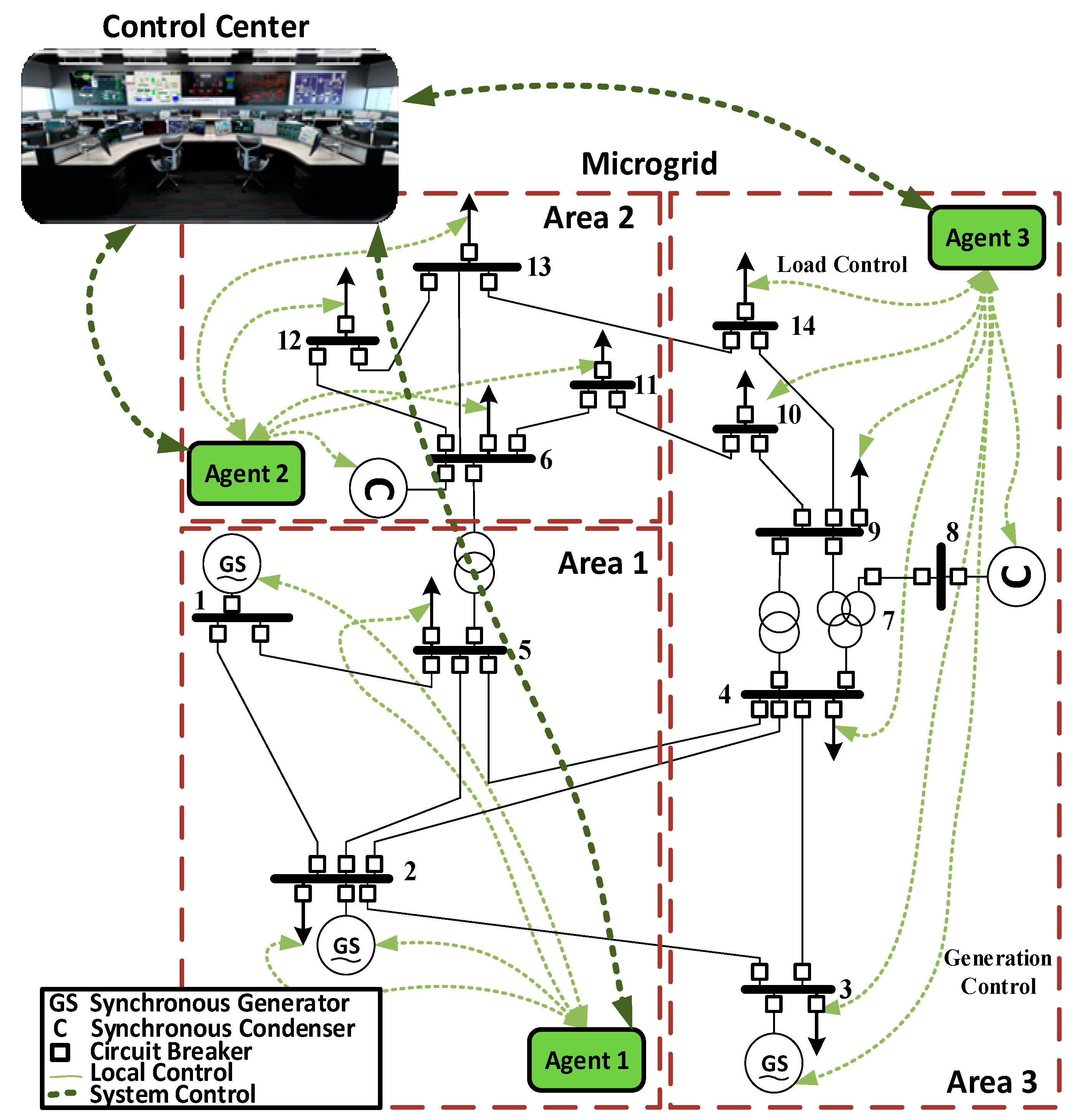
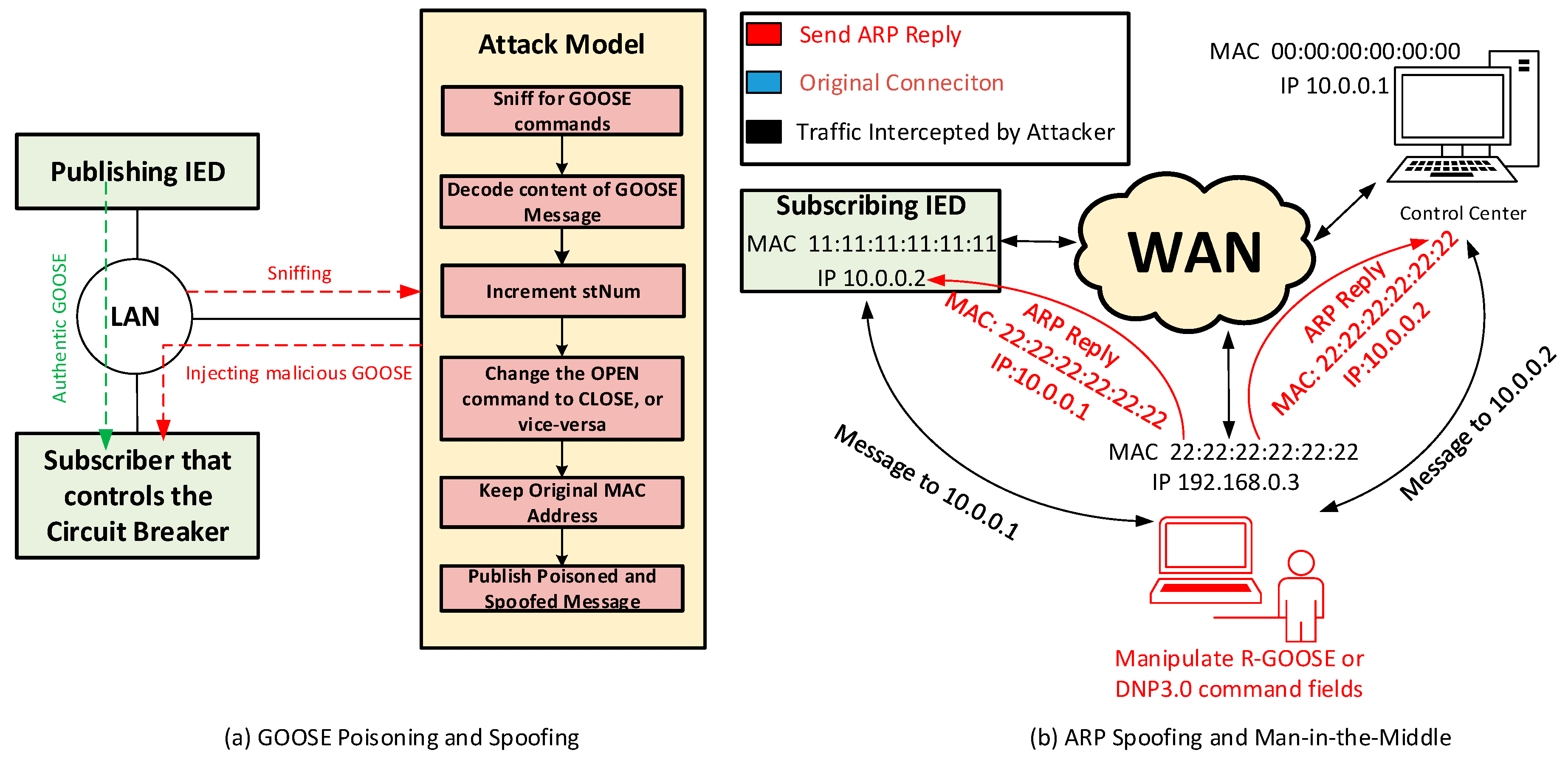
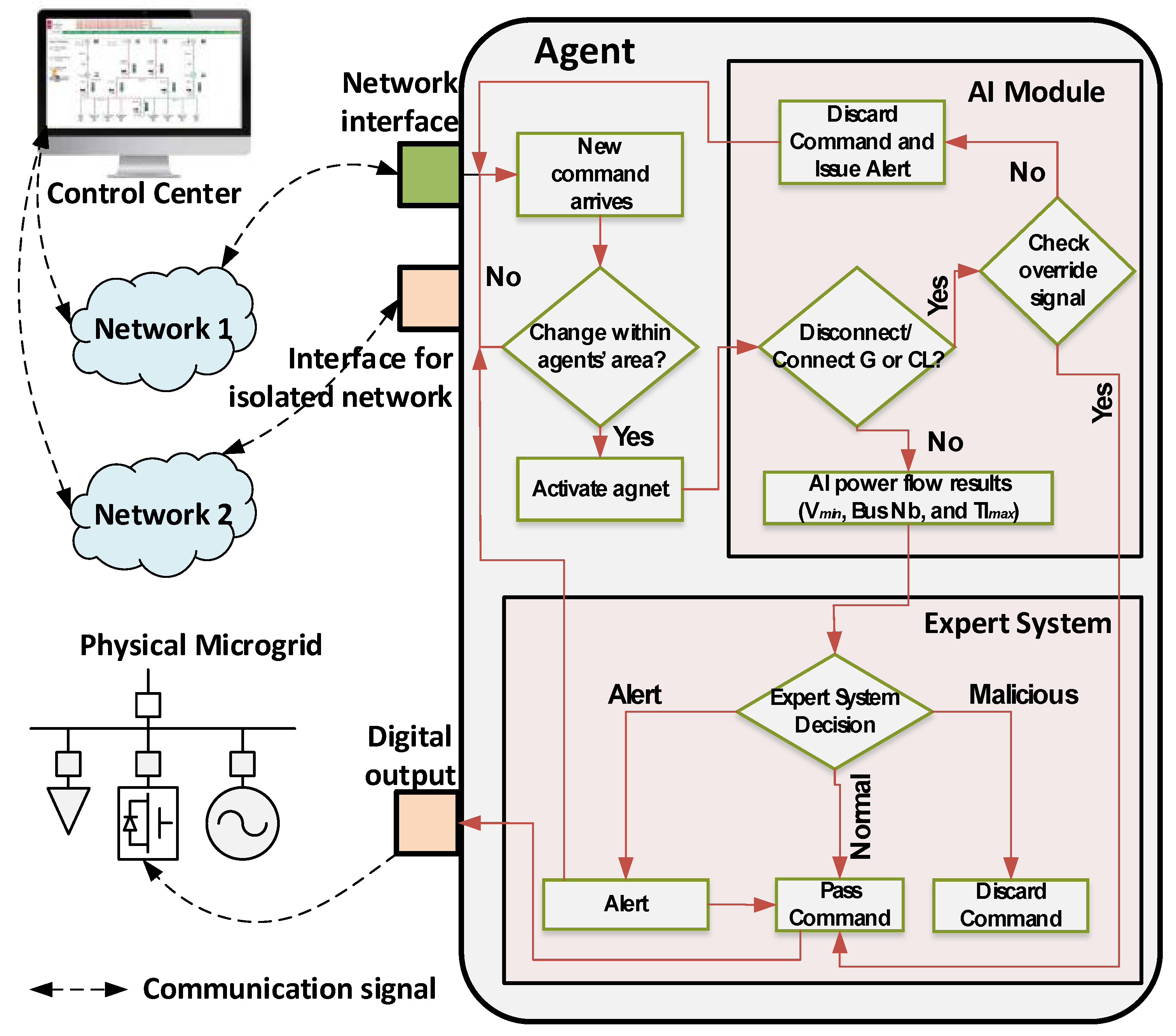
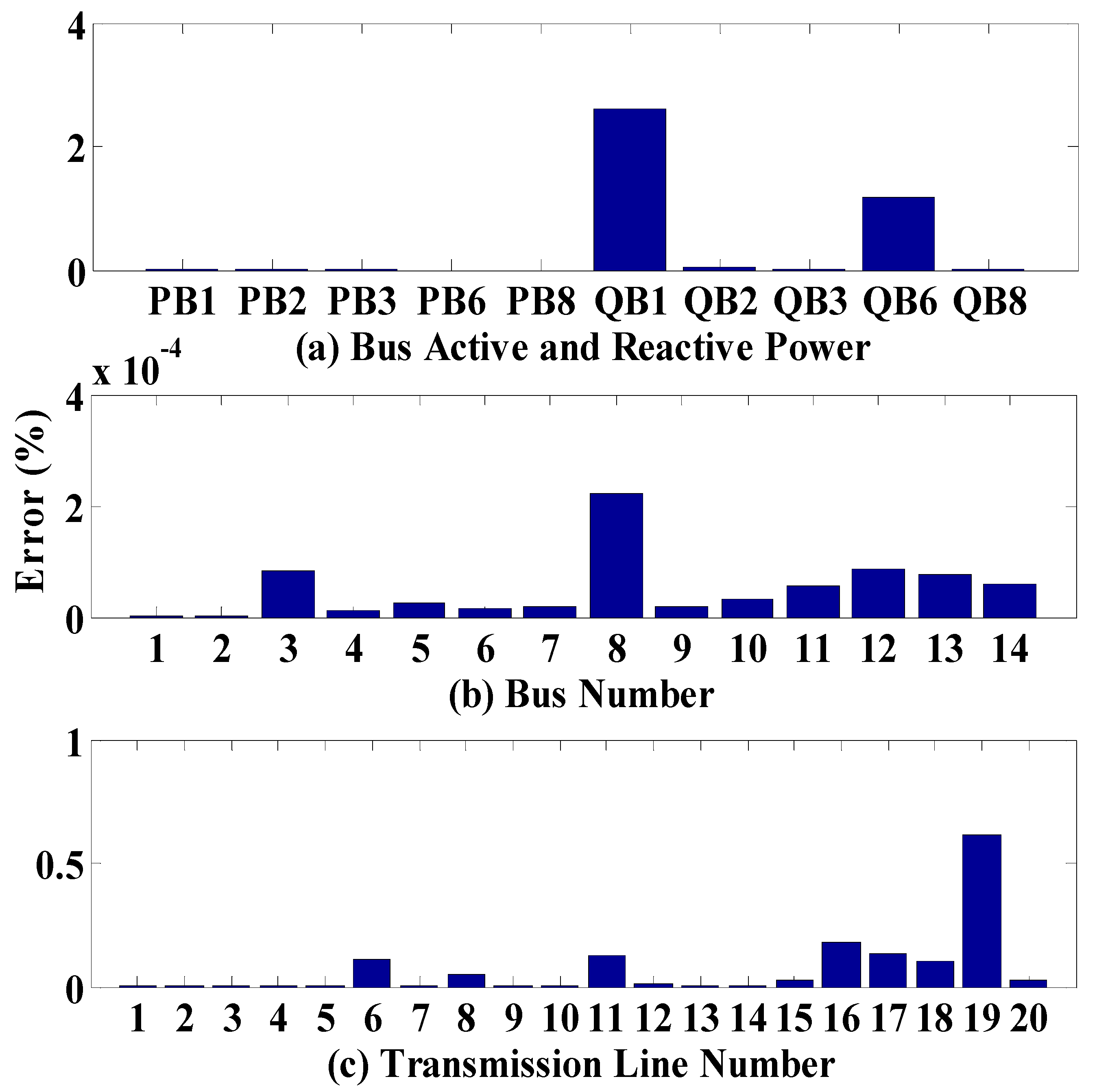
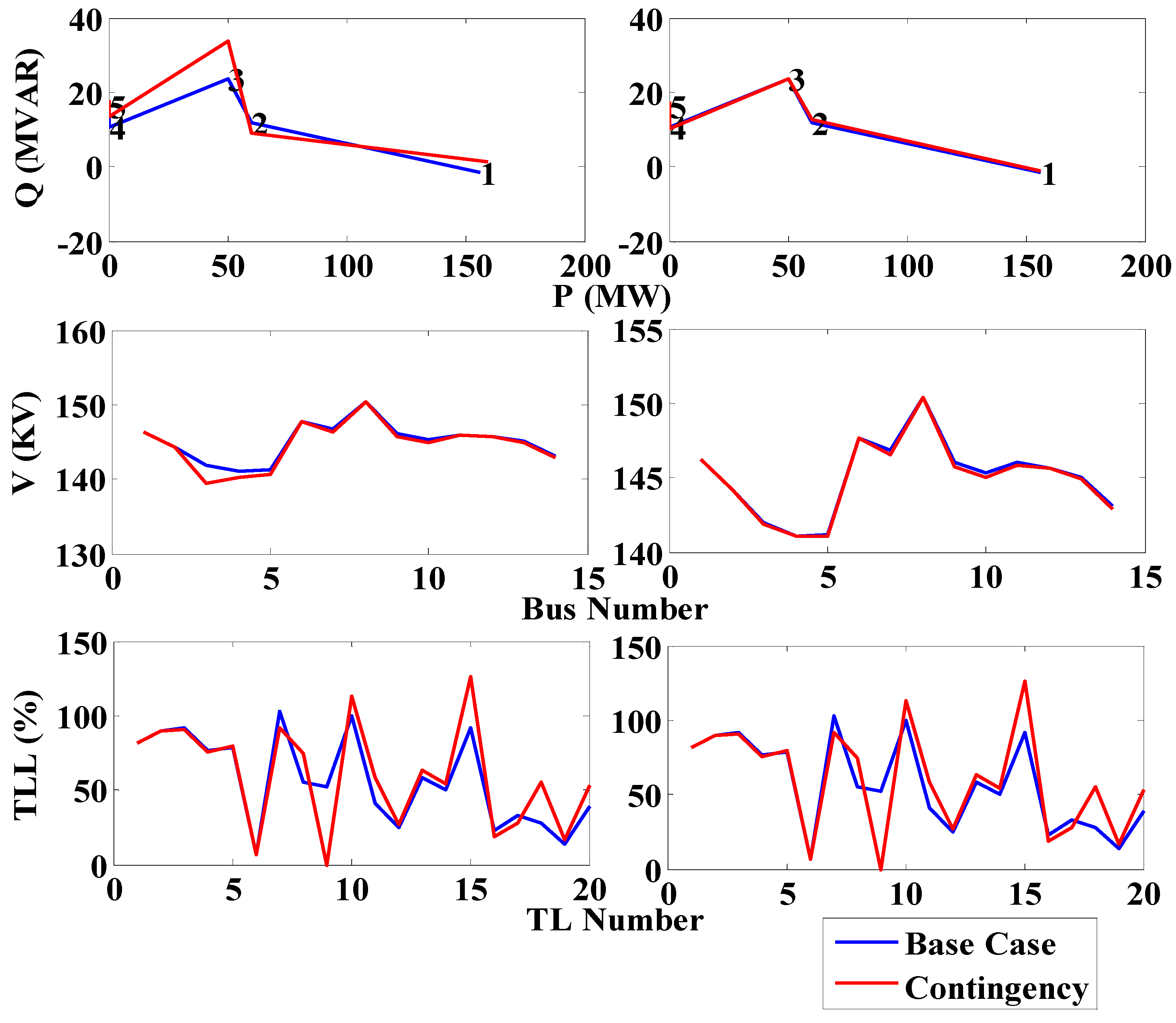
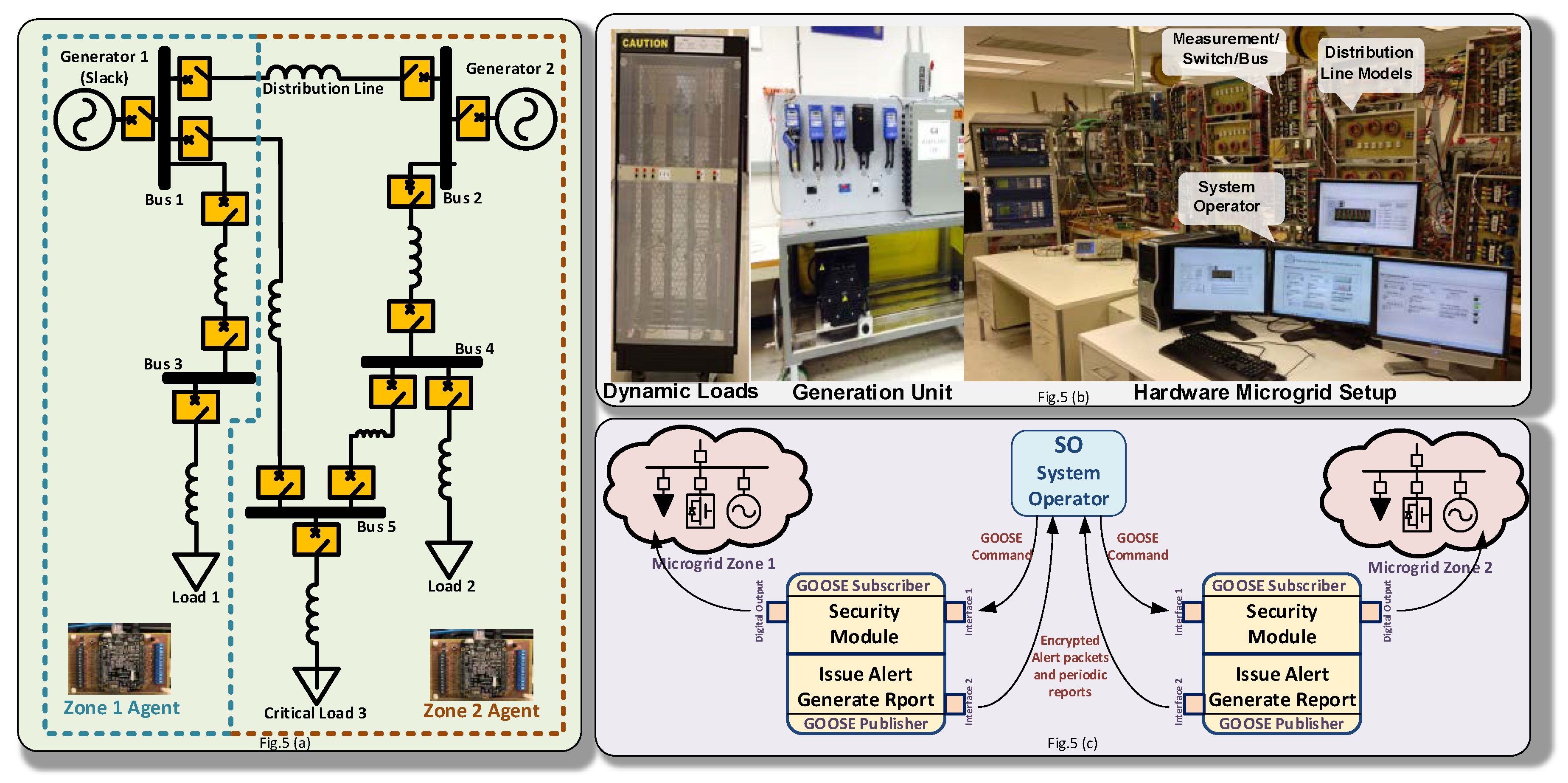
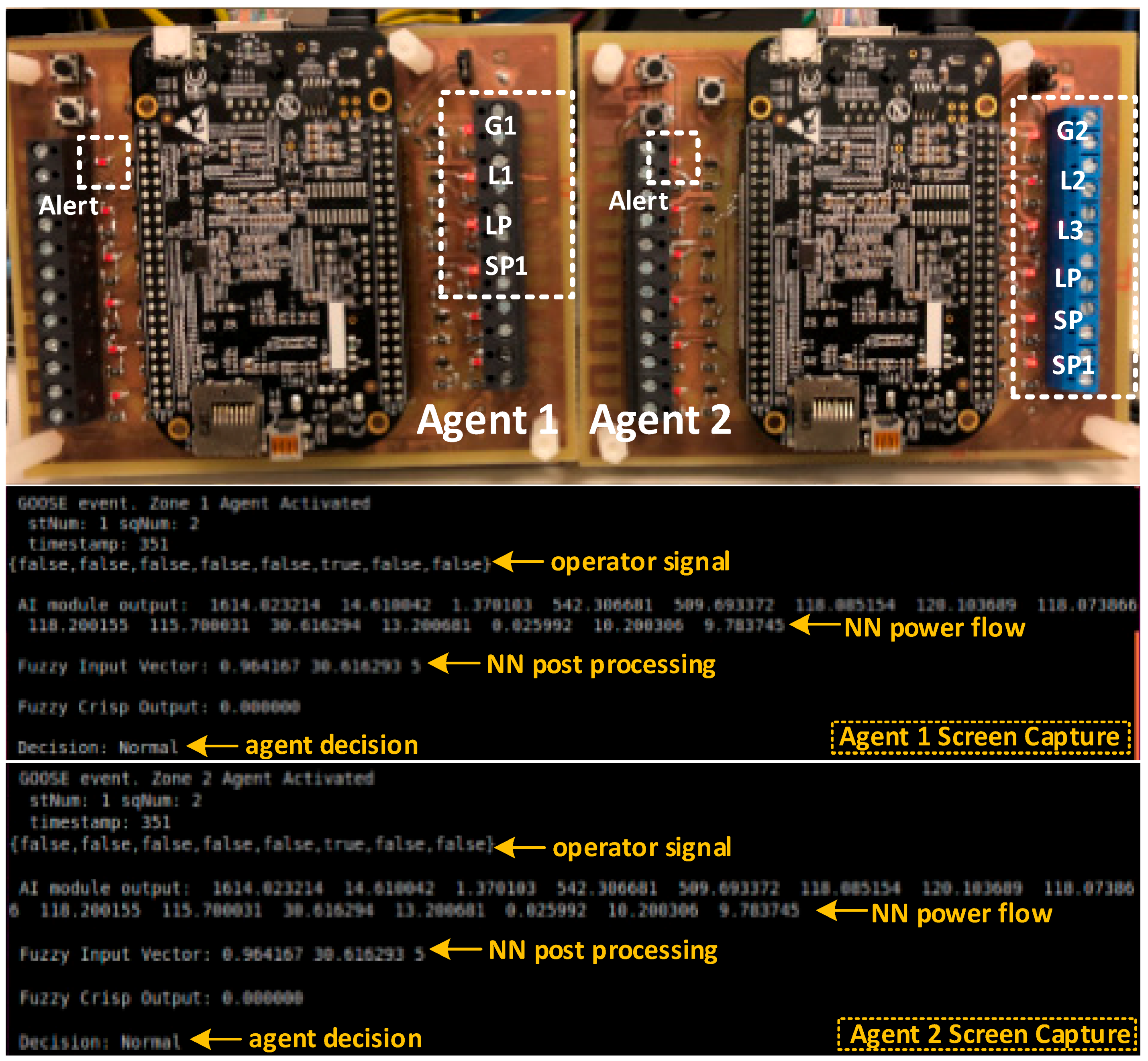
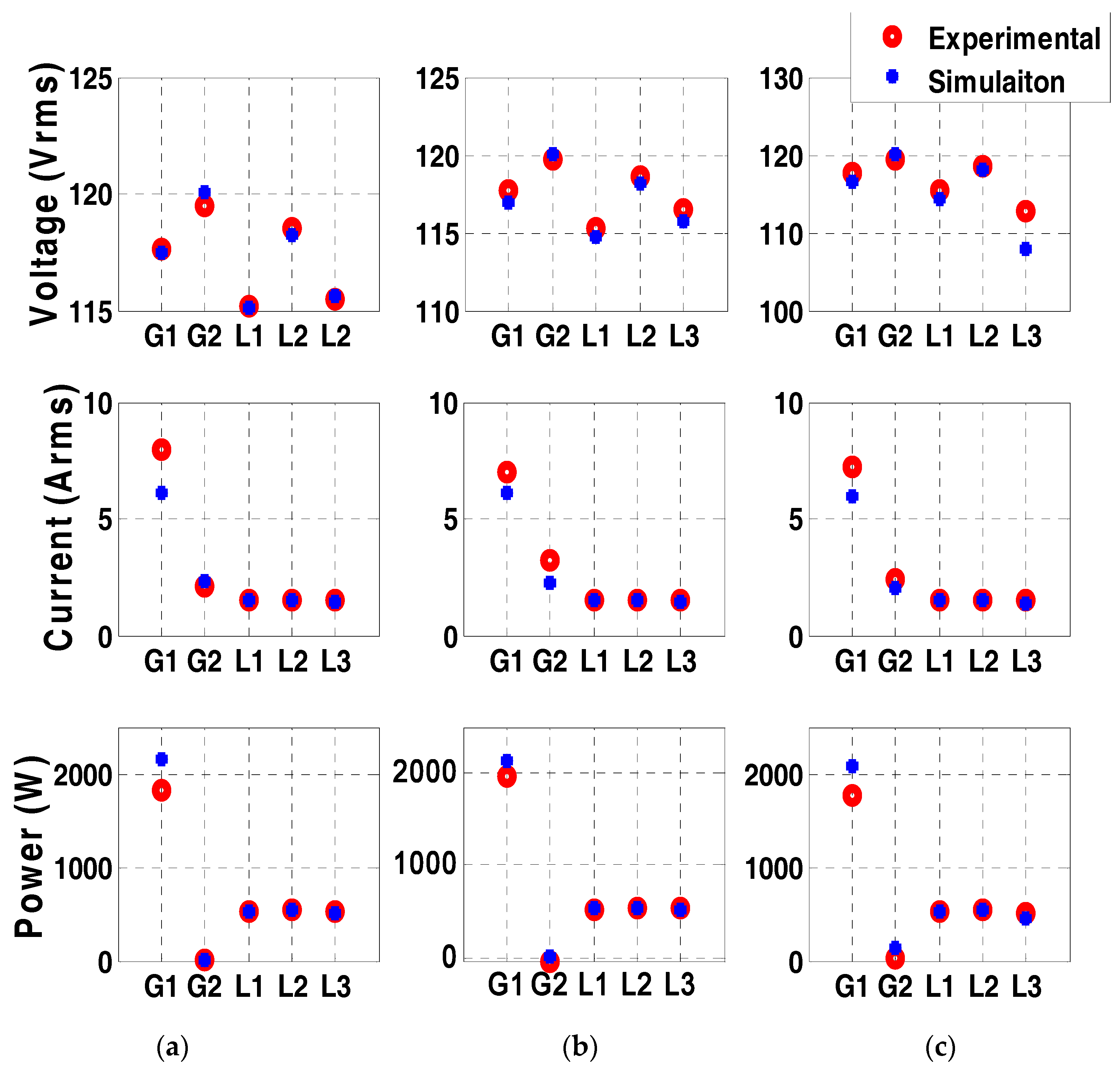

| Message Type | Open System Interconnect Layer | Network | Assumed Attacks |
|---|---|---|---|
| GOOSE | Layer 2 Data Link (MAC) | LAN | GOOSE Poisoning and Spoofing |
| R-GOOSE | Layer 3 Network (IP) | LAN/WAN | ARP Poisoning Man-in-the-Middle |
| DNP3.0 | Layer 4 Transport (TCP/IP) | LAN/WAN | ARP Poisoning Man-in-the-Middle |
| a | b | c | d | ||
|---|---|---|---|---|---|
| Voltage (V p.u.) | VL | 0 | 0 | 0.872 | 0.92 |
| L | 0.9 | 0.924 | 0.924 | 0.95 | |
| H | 0.94 | 1 | 1 | 1.05 | |
| VH | 1.03 | 1.04 | 2.082 | 2.36 | |
| TLL (%) | N | 0 | 0 | 73 | 105 |
| LTE | 100 | 115 | 115 | 130 | |
| STE | 128 | 148 | 200 | 200 |
| Compare w. NC | Sequential | Compare w. NC | Sequential | ||||||||||||||||||
|---|---|---|---|---|---|---|---|---|---|---|---|---|---|---|---|---|---|---|---|---|---|
| Case | Vmin (pu) | Bus Nb. | TLLmax (%) | A1 | A2 | A3 | A1 | A2 | A3 | Case | Vmin (pu) | Bus Nb. | TLLmax (%) | A1 | A2 | A3 | A1 | A2 | A3 | ||
| NC | 1.02 | 4 | 103 | NC | 1.02 | 4 | 103 | ||||||||||||||
| 1 | B1–B2 | 1.02 | 5 | 252 | 19 | 12–13 | 1.02 | 4 | 103 | ||||||||||||
| 2 | B1–B5 | 1.01 | 5 | 134 | 20 | 13–14 | 1.02 | 4 | 106 | ||||||||||||
| 3 | B2–B3 | 1.01 | 3 | 156 | 21 | GB1 | n/a | n/a | n/a | ||||||||||||
| 4 | B2–B4 | 1.01 | 4 | 180 | 22 | G B2 | n/a | n/a | n/a | ||||||||||||
| 5 | B2–B5 | 1.01 | 5 | 113 | 23 | G B3 | n/a | n/a | n/a | ||||||||||||
| 6 | B3–B4 | 1.02 | 5 | 102 | 24 | G B6 | n/a | n/a | n/a | ||||||||||||
| 7 | B4–B5 | 1.02 | 4 | 131 | 25 | G B8 | n/a | n/a | n/a | ||||||||||||
| 8 | B4–B7 | 1.02 | 4 | 130 | 26 | CL B9 | n/a | n/a | n/a | ||||||||||||
| 9 | B4–B9 | 1.02 | 4 | 123 | 27 | L B6 | 1.02 | 4 | 103 | ||||||||||||
| 10 | B5–B6 | 0.99 | 12 | 198 | 28 | L B5 | 1.02 | 4 | 102 | ||||||||||||
| 11 | B6–11 | 1.02 | 4 | 108 | 29 | CL B4 | n/a | n/a | n/a | ||||||||||||
| 12 | B6–12 | 1.02 | 4 | 103 | 30 | CL B3 | n/a | n/a | n/a | ||||||||||||
| 13 | B6–13 | 0.99 | 13 | 108 | 31 | CL B2 | n/a | n/a | n/a | ||||||||||||
| 14 | B7–B8 | 0.02 | 8 | 100 | 32 | L B14 | 1.03 | 4 | 98 | ||||||||||||
| 15 | B7–B9 | 1.02 | 14 | 129 | 33 | L B13 | 1.02 | 4 | 103 | ||||||||||||
| 16 | B9–10 | 1.02 | 5 | 108 | 34 | L B12 | 1.02 | 4 | 102 | ||||||||||||
| 17 | B9–14 | 0.99 | 14 | 117 | 35 | L B11 | 1.02 | 4 | 102 | ||||||||||||
| 18 | 10–11 | 1.02 | 4 | 107 | 36 | L B10 | 1.02 | 4 | 102 | ||||||||||||
| Cases (Figure 8) | Description | Vmin (pu) | Bus Nb. | TLLmax (%) | A1 | A2 |
|---|---|---|---|---|---|---|
| R1 | NC | 0.95 | 3 | 40.8 | ||
| R2 | Open CB G1 | --- | --- | --- | ||
| R3 | Open CB G2 | --- | --- | --- | ||
| R4 | Open CB L1 | 0.96 | 5 | 30.6 | ||
| R5 | Open CB CL3 | --- | --- | --- | ||
| R6 | Open CB L2 | 0.96 | 3 | 30.5 | ||
| R7 | Open CB B4–B5 | 0.90 | 5 | 40.0 | ||
| R8 | Open CB B1–B5 | 0.95 | 3 | 40.9 | ||
| R9 | Open CB B1–B2 | 0.92 | 3 | 52.7 |
© 2018 by the authors. Licensee MDPI, Basel, Switzerland. This article is an open access article distributed under the terms and conditions of the Creative Commons Attribution (CC BY) license (http://creativecommons.org/licenses/by/4.0/).
Share and Cite
El Hariri, M.; Faddel, S.; Mohammed, O. Physical-Model-Checking to Detect Switching-Related Attacks in Power Systems. Sensors 2018, 18, 2478. https://doi.org/10.3390/s18082478
El Hariri M, Faddel S, Mohammed O. Physical-Model-Checking to Detect Switching-Related Attacks in Power Systems. Sensors. 2018; 18(8):2478. https://doi.org/10.3390/s18082478
Chicago/Turabian StyleEl Hariri, Mohamad, Samy Faddel, and Osama Mohammed. 2018. "Physical-Model-Checking to Detect Switching-Related Attacks in Power Systems" Sensors 18, no. 8: 2478. https://doi.org/10.3390/s18082478
APA StyleEl Hariri, M., Faddel, S., & Mohammed, O. (2018). Physical-Model-Checking to Detect Switching-Related Attacks in Power Systems. Sensors, 18(8), 2478. https://doi.org/10.3390/s18082478







